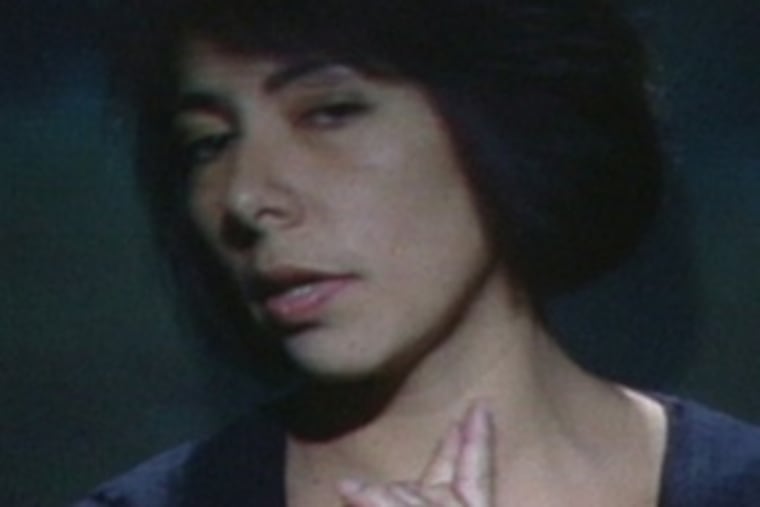Channeling sounds from Earth and far beyond.
Artfully arranged cairns have radios at their core

Remember the crystal radios - "foxhole receivers" - that GIs at Anzio in 1944 constructed from coiled wire, razor blades, pencil lead and a little ingenuity (and the more sophisticated versions built by science-nerd kids in the '40s and '50s)? They're back.
In 1998, artist Dove Bradshaw learned that crystal radios commonly incorporate pyrite, which she had used in "time-sculptures" of minerals and rocks that changed over time, through natural chemical reactions or reactions she facilitated. She realized that the radios were somehow meant to be united with her work.
Eight years later, she began making works she called "Radio Rock" (a single rock with a crystal radio) or "Radio Rocks" (a loosely pyramidal arrangement of rocks containing radios). The shapes of Bradshaw's three recent "Radio Rocks," at Larry Becker Contemporary Art, are based on cairns, the Neolithic astronomical markers still found in rural Scotland. Each consists of a specific type of rock (Pocono sandstone, Wissahickon schist, basalt), contains three radios (receiving local, world band short-wave, or outer space frequency), and each acts as its own multidirectional antenna.
Bradshaw's previous time-sculptures have been simpler gestures involving chance. Works from her 1995 "Indeterminacy" series, for example, consisted of a chunk of pyrite balanced on a piece of white marble. The pieces were weathered outdoors for six months before they were exhibited; the occasional rain or snow would cause the pyrite to leach, staining the marble in various patterns.
Her new pieces use real, if low-tech, technology: Pyrite is a mixer for her radios, as are fluorite, galena, tourmaline and hematite. Incredibly, one of the radios in her "Radio Rocks II" receives live signals of radio emissions from Jupiter transmitted from a radio telescope at Pisgah Astronomical Research Institute in Rosman, N.C. (Jupiter sounds as you would expect - extremely distant and active.)
Obviously, this is work that both gains and loses in the telling. It doesn't beg to be explained - but Bradshaw dutifully describes her materials and processes in her catalogue, as she always has, and, once read, that becomes a mantra to be passed on. The problem is that there is so much explaining to do for this particular body of work that it detracts from the quirky poetry of her radio-infiltrated cairns. They are delightfully idiosyncratic, humorous mysteries just as they are.
Bradshaw is also showing pencil-on-paper studies for her "Radio Rocks," works on paper in which she shoots an injection of liver of sulfur onto silver leaf, allowing the reaction to take its own strange course (the results look vaguely like ancient maps), and new "Quick Constructions," created by tossing cut paper templates on paper brushed with beeswax.
Nosey
Art and science are converging in West Philadelphia too, this month and next, at the Esther M. Klein Art Gallery.
Odor Limits
gathers the works of four artists exploring the expressive potential of scent, odor, fragrance or perfume (not everyone perceives the same scent the same way, you soon learn). Organized by Jim Drobnick and Jennifer Fisher, and accompanied by an essay by Leslie Stein of Philadelphia's Monell Chemical Senses Center, it's a perfect show for the lobby of the University City Science Center. What the works lack in visual aplomb, they more than make up for with innovative ideas, unpretentious charm and accessibility.
Case in point: Oswaldo Macia's
1 Woodchurch Road, London NW6 3PL
, which comprises several trash cans filled with a sand-like material infused with scents from his London apartment complex. You lift the lids expecting something obvious and putrid, and instead get baby powder, Listerine, mothballs, eucalyptus and olive oil.
Smellscape
, his installation of wall-mounted Plexiglas boxes done in collaboration with perfumer Ricardo Moya, offers scents both sweet and stinky, inspired by the notes of Phileas Fogg in Jules Verne's
Around the World in Eighty Days
. The generous olfactory experiences of this work far outweigh its presentation.
Jenny Marketou's video,
SMELLYOU>SMELLME
, is another case of not looking like much while being entirely diverting. In it, a variety of men and women answer Marketou's questions about the sense of smell. Their responses are consistently surprising - and surprisingly intimate.
Chrysanne Stathacos' customized art deco
Wish Machine
will solve your life dilemmas by dispensing a plastic-bagged photocollage plus a vial of a related plant-based essential oil such as basil, for money, or rose, for love.
The show's most memorable work is Clara Ursitti's untitled video from 1995, in which she reclines, Odalisque-style, while Dr. George Dodd, a scientist, perfumer and aromatherapist sniffs her and talks about the scents produced by various parts of the human anatomy. It is a Hannibal Lecter-worthy scrutiny of scent, and completely mesmerizing.